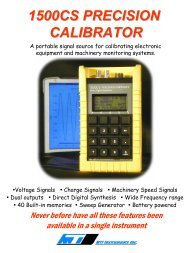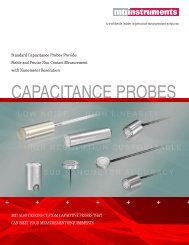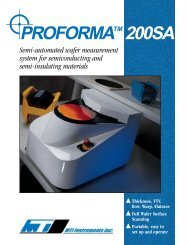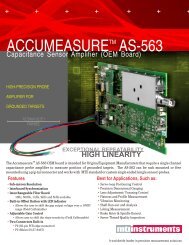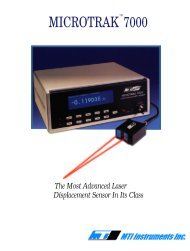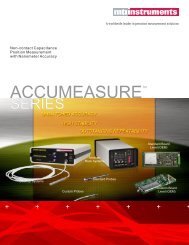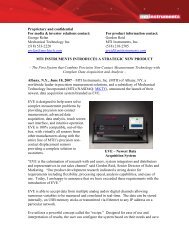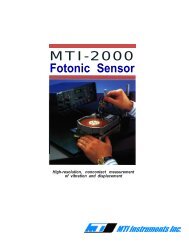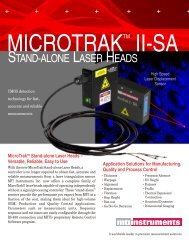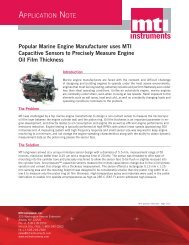APPLICATION NOTE: Laser Triangulation Sensors - MTI Instruments ...
APPLICATION NOTE: Laser Triangulation Sensors - MTI Instruments ...
APPLICATION NOTE: Laser Triangulation Sensors - MTI Instruments ...
Create successful ePaper yourself
Turn your PDF publications into a flip-book with our unique Google optimized e-Paper software.
<strong>MTI</strong>I’s laser sensors have through holes that can be used to mount and secure the laser<br />
heads. Fixtures should be made to match the location of these holes and maintain the<br />
laser head perpendicular to the target of interest.<br />
v.) Synchronization<br />
When making differential thickness measurements with 2 laser heads it is important to<br />
take and process measurements from both heads at the exact same time. This is to<br />
eliminate the effects due to vibration. If the target is moving, and measurements are taken<br />
at slightly different times, the processed results may report a slightly thinner or thicker<br />
target. <strong>MTI</strong>I’s Microtrak II line of laser sensors have provisions to synchronize heads<br />
eliminating this problem.<br />
4) Advantages and Disadvantages<br />
i.) Advantages<br />
As with any sensing technology, laser systems have both advantages and disadvantages.<br />
Perhaps their greatest attribute is their ability to resolve measurements below one micron<br />
at a fraction of the cost of other high performance technologies. In addition, their<br />
measurement range is large allowing them to fulfill a variety of application requirements.<br />
The large operating distance provides sufficient standoff to reduce possible damage from<br />
contacting the moving target.<br />
ii.) Disdvantages<br />
As mentioned above, laser sensors should be kept clean. Dirt or other foreign debris can<br />
affect accuracy so frequent cleaning may be required. Because laser heads have sensitive<br />
electronic components their operating temperature is limited and vacuum installations are<br />
not recommended without external cooling.<br />
5) Applications<br />
i.) Position Sensing<br />
General positioning is probably the most common application for laser sensors. Their<br />
fast, highly linear response makes them ideally suited to be applied in both static and<br />
active feedback positioning applications. Large operating distance and measurement<br />
range provides the flexibility for process and quality control monitoring. Typical<br />
applications include:<br />
• Pavement and concrete road profiling<br />
• Railroad track alignment<br />
• Robot location<br />
• Welding head position



